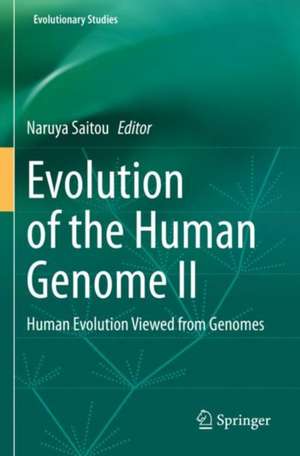Evolution of the Human Genome II: Human Evolution Viewed from Genomes
Editat de Naruya Saitouen Limba Engleză Paperback – 29 mai 2022
The most significant feature of this book is the continent-wise discussion of modern human dispersal using human genomic data in Part II. Recent results such as introgression of paleogenomes to modern humans, new methods such as computer simulation of global human dispersals, and new information on genes for humanness will be of particular interest to the readers. Since the euchromatin regions of the human genome was sequenced in 2003, a huge number of research papers were published on modern human evolution for a variety ofpopulations. It is now time to summarize these achievements.
This book stands out as the most comprehensive book on the modern human evolution, focusing on genomic points of view with a broad scope. Primary target audiences are researchers and graduate students in evolutionary biology.
| Toate formatele și edițiile | Preț | Express |
|---|---|---|
| Paperback (1) | 882.74 lei 39-44 zile | |
| Springer – 29 mai 2022 | 882.74 lei 39-44 zile | |
| Hardback (1) | 1105.66 lei 3-5 săpt. | |
| Springer – 28 mai 2021 | 1105.66 lei 3-5 săpt. |
Preț: 882.74 lei
Preț vechi: 1161.50 lei
-24% Nou
Puncte Express: 1324
Preț estimativ în valută:
168.99€ • 174.18$ • 142.48£
168.99€ • 174.18$ • 142.48£
Carte tipărită la comandă
Livrare economică 24 februarie-01 martie
Preluare comenzi: 021 569.72.76
Specificații
ISBN-13: 9784431569053
ISBN-10: 4431569057
Pagini: 260
Ilustrații: VIII, 260 p. 42 illus., 27 illus. in color.
Dimensiuni: 155 x 235 mm
Ediția:1st ed. 2021
Editura: Springer
Colecția Springer
Locul publicării:Tokyo, Japan
ISBN-10: 4431569057
Pagini: 260
Ilustrații: VIII, 260 p. 42 illus., 27 illus. in color.
Dimensiuni: 155 x 235 mm
Ediția:1st ed. 2021
Editura: Springer
Colecția Springer
Locul publicării:Tokyo, Japan
Cuprins
Part I: Genes for Humanness.- Chapter 1. Anthropogeny.- Chapter 2. Transcriptome.- Chapter 3. Genes related to skeletal morphology.- Chapter 4. Genes related to high altitude adaptation.- Chapter 5. Neutrally evolved genes.- Part II: Evolution of Modern Human Populations.- Chapter 6. Mitochondrial DNA.- Chapter 7. Y chromosome.- Chapter 8. Africa.- Chapter 9. West and South Asia.- Chapter 10. Europe.- Chapter 11. Southeast Asia.- Chapter 12. Oceania.- Chapter 13. Continental East Asia.- Chapter 14. Japanese Archipelago .- Chapter 15. America.- Chapter 16. Neanderthals.- Chapter 17. Simulations of human dispersal.- Index.
Notă biografică
Dr. Naruya Saitou is a Professor in Population Genetics Laboratory at the National Institute of Genetics, and a concurrent Professor in the Department of Genetics at the Graduate University for Advanced Studies, Mishima, Japan. He is also a Specially Appointed Professor in the School of Medicine, University of the Ryukyus, Okinawa, Japan and a concurrent Professor in the Department of Biological Sciences at the University of Tokyo, Japan.
Textul de pe ultima copertă
This two-volume set provides a general overview of the evolution of the human genome; The first volume overviews the human genome with descriptions of important gene groups. This second volume provides up-to-date, concise yet ample knowledge on the genome evolution of modern humans. It comprises twelve chapters divided into two parts discussing “Non-neutral Evolution on Human Genes” (Part I) and “Evolution of Modern Human Populations” (Part II.)
The most significant feature of this book is the continent-wise discussion of modern human dispersal using human genomic data in Part II. Recent results such as introgression of paleogenomes to modern humans, new methods such as computer simulation of global human dispersals, and new information on genes for humanness will be of particular interest to the readers. Since the euchromatin regions of the human genome was sequenced in 2003, a huge number of research papers were published on modern human evolution for a variety of populations. It is now time to summarize these achievements.
This book stands out as the most comprehensive book on the modern human evolution, focusing on genomic points of view with a broad scope. Primary target audiences are researchers and graduate students in evolutionary biology.
The most significant feature of this book is the continent-wise discussion of modern human dispersal using human genomic data in Part II. Recent results such as introgression of paleogenomes to modern humans, new methods such as computer simulation of global human dispersals, and new information on genes for humanness will be of particular interest to the readers. Since the euchromatin regions of the human genome was sequenced in 2003, a huge number of research papers were published on modern human evolution for a variety of populations. It is now time to summarize these achievements.
This book stands out as the most comprehensive book on the modern human evolution, focusing on genomic points of view with a broad scope. Primary target audiences are researchers and graduate students in evolutionary biology.
Caracteristici
Provides necessary knowledge on genome evolution of modern humans Shows continent-wise discussion of modern human dispersal using human genomic data Edited and contributed by leading experts in genome evolution
